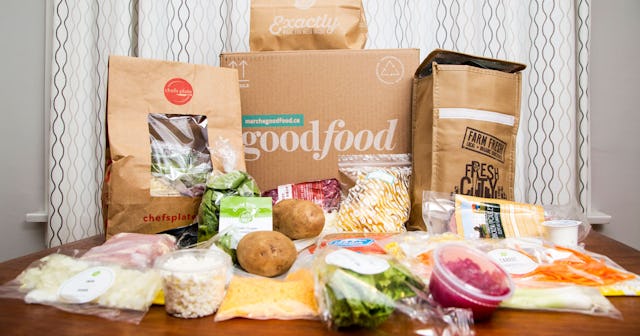Study Finds Meal Kits Have A Smaller Carbon Footprint Than Grocery Shopping

A study found that meal kits are actually better for the planet than grocery stores
Weary of meal kits like Blue Apron and HelloFresh because they’re packed in environment-killing wrappings of cardboard and plastic? Well, you may want to reconsider that stance. A new study found that those meal delivery services actually have a smaller carbon footprint than buying food from grocery stores.
The scientific journal Resources, Conservation and Recycling published a report that argued companies like Blue Apron are actually the greener way to go. Researchers explained that, unlike meal kit services, grocery store meals are not pre-portioned which leads to more waste. They produce 33 percent (!!) more greenhouse gas than meal kit services and also have higher transportation emissions.
“Meal kits are designed for minimal food waste,” Shelie Miller, senior author of the study, explained, per University of Michigan’s website. “So, while the packaging is typically worse for meal kits, it’s not the packaging that matters most. It’s food waste and transportation logistics that cause the most important differences in the environmental impacts of these two delivery mechanisms.”
They tested this theory by ordering five Blue Apron meals, buying the exact same ingredients from a grocery store, and cooking both. Miller told NPR that the researchers “measured every bit of food, plastic, bits of cardboard, everything for each type of meal.” Pretty surprisingly, the conclusion came out in favor of Blue Apron.
https://www.instagram.com/p/Bwcdk4tIu7o/
But what about all of that cardboard and plastic that these services use? Miller noted that there’s a really important trade-off between the meal kit packaging and the lack of food waste they promote.
“Our results are likely to be a surprise to many, since meal kits tend to get a bad environmental rap due to their packaging,” she said. “Even though it may seem like that pile of cardboard generated from a Blue Apron or Hello Fresh subscription is incredibly bad for the environment, that extra chicken breast bought from the grocery store that gets freezer-burned and finally gets thrown out is much worse, because of all the energy and materials that had to go into producing that chicken breast in the first place.”
It looks like meal kit services have become a major force to be reckoned with. In 2018, they made a whopping $3.1 billion in sales and had a 22 percent growth rate. 25 percent of people who responded to a Nielsen survey said that they planned on ordering a meal kit in the next six months.
“The way consumers purchase and receive food is undergoing substantial transformation, and meal kits are likely to be part of it in some way,” University of Michigan doctoral student Brent Heard said. “In order to minimize overall impacts of the food system, there is a need to continue to reduce food loss and waste, while also creating advances in transportation logistics and packaging to reduce last-mile emissions and material use.”
Seeing as the effects of climate change are really, really scary and happening literally right now, meal kits sound like a potentially great way to lower our carbon footprint.